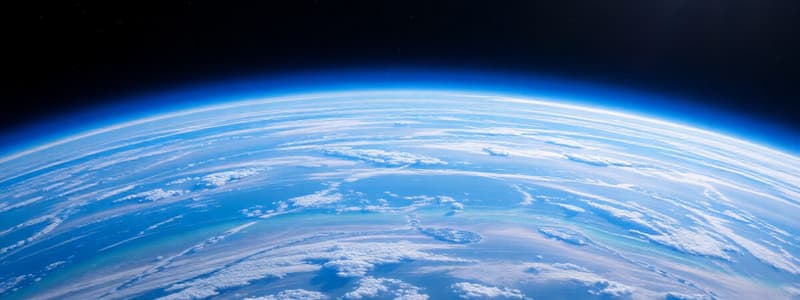Podcast
Questions and Answers
Which layer of the Earth's atmosphere is closest to the surface?
Which layer of the Earth's atmosphere is closest to the surface?
- Thermosphere
- Stratosphere
- Troposphere (correct)
- Mesosphere
Which atmospheric layer contains the ozone layer?
Which atmospheric layer contains the ozone layer?
- Mesosphere
- Thermosphere
- Stratosphere (correct)
- Troposphere
In which atmospheric layer does temperature generally decrease with altitude?
In which atmospheric layer does temperature generally decrease with altitude?
- Mesosphere
- Thermosphere
- Stratosphere
- Troposphere (correct)
Which layer hosts the International Space Station?
Which layer hosts the International Space Station?
In which layer of the atmosphere do most weather events occur?
In which layer of the atmosphere do most weather events occur?
What is the coldest layer of the atmosphere?
What is the coldest layer of the atmosphere?
Which atmospheric layer is closest to outer space?
Which atmospheric layer is closest to outer space?
Which layer of the atmosphere contains the ionosphere?
Which layer of the atmosphere contains the ionosphere?
In which of these layers does temperature increase with altitude?
In which of these layers does temperature increase with altitude?
What is the approximate height of the troposphere?
What is the approximate height of the troposphere?
Flashcards
Troposphere
Troposphere
The layer closest to Earth, containing the air needed for breathing and photosynthesis. Temperature decreases with height.
Stratosphere
Stratosphere
The second layer of the atmosphere, containing the ozone layer which protects Earth from harmful UV radiation. Temperature increases with height.
Mesosphere
Mesosphere
The coldest layer of the atmosphere, located between the stratosphere and thermosphere.
Thermosphere
Thermosphere
Signup and view all the flashcards
Exosphere
Exosphere
Signup and view all the flashcards
Ionosphere
Ionosphere
Signup and view all the flashcards
Atmospheric Layers
Atmospheric Layers
Signup and view all the flashcards
Ozone Layer
Ozone Layer
Signup and view all the flashcards
Study Notes
- The Earth's atmosphere consists of four main layers: troposphere, stratosphere, mesosphere, and thermosphere, which constitute its vertical structure.
- The exosphere is the atmosphere's uppermost layer, gradually fading into space and characterized by extremely thin air.
Layers
- From lowest to highest, the Earth's atmosphere layers are: troposphere, stratosphere, mesosphere, and thermosphere.
- These layers facilitate the sun's warming of the Earth, provide breathable air, and enable global communication and travel.
Troposphere
- The troposphere is the atmosphere's layer closest to Earth, extending up to about 7.5 miles (12 kilometers).
- Its height varies, being lower at the poles and higher at the Equator.
- It contains the air necessary for animals, humans, and plants.
- The troposphere's mix of nitrogen, oxygen, and carbon dioxide sustains life on Earth.
- Air temperature decreases with increasing elevation in the troposphere due to heat transfer from the Earth's surface.
- As the densest atmospheric layer, most of Earth's weather occurs in the troposphere.
- Most clouds are within the troposphere, with some exceptions like cumulonimbus clouds.
- Aviation primarily occurs in the troposphere and a small region between it and the stratosphere.
Stratosphere
- The stratosphere lies above the troposphere, extending up to about 31 miles (50 kilometers) above the Earth's surface.
- It contains virtually no clouds or weather, and is the highest part of the atmosphere that jets and airplanes can reach.
- Unlike the troposphere, temperature increases with height in the stratosphere due to UV radiation.
- The stratosphere contains the ozone layer, protecting Earth from harmful ultraviolet radiation.
- Increased carbon emissions can cause ozone depletion, leading to ozone holes and increased UV radiation.
Mesosphere
- The mesosphere is the next atmospheric layer and the coldest, located between 31 and 50 miles (50 to 80 kilometers) above the Earth's surface.
- Temperatures in the mesosphere average about minus 120 degrees Fahrenheit.
- The highest clouds form in this layer due to scarce water vapor.
- It contains the ionosphere, where Earth-orbiting satellites are located, critical for communication.
- The ionosphere reflects and modifies radio waves, and scientists constantly measure and create models to predict signal disruptions due to the varying electrical charges in this layer.
Thermosphere
- The thermosphere is the last atmospheric layer, extending from about 50 miles to 440 miles (700 kilometers) above Earth, giving way to space.
- The International Space Station and other orbiting satellites, including part of the ionosphere, are located within the thermosphere.
Studying That Suits You
Use AI to generate personalized quizzes and flashcards to suit your learning preferences.




